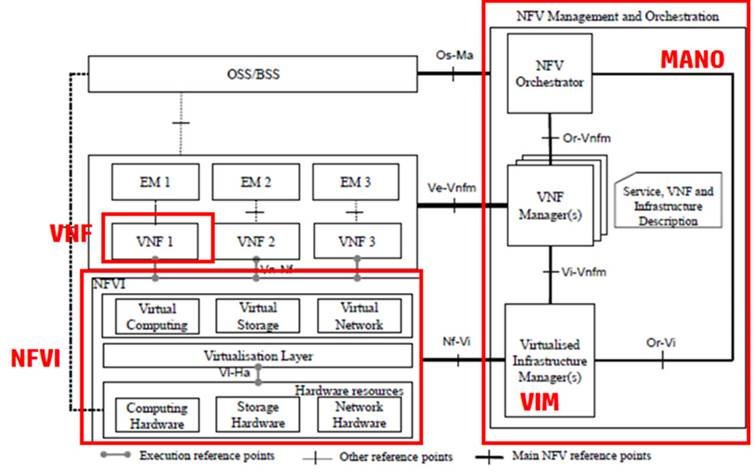Introduction
The advent of 5G has ushered in an era of unprecedented connectivity, speed, and efficiency in the world of telecommunications. This leap forward, however, brings with it a complexity that demands a sophisticated approach to network management. In this context, understanding the roles and interactions of various network management components – Element Management System (EMS), Virtual Network Functions (VNFs), Network Management System (NMS)/Operations Support System (OSS), and Orchestrator – becomes crucial. Furthermore, as we look towards the horizon of 6G, it’s essential to evaluate whether these systems will suffice or require modifications.
Keywords: 5G Network Management, Element Management System (EMS), Virtual Network Functions (VNFs), Network Management System (NMS), Operations Support System (OSS), Network Orchestrator, 5G Network Architecture, Network Scalability, Network Flexibility, Network Efficiency, 6G Technology, AI Integration in Networking, Advanced Security Protocols, Telecommunications Evolution, Dynamic Resource Allocation, Service Agility in Networks, High Data Rate Networks, Low Latency Networking, IoT Connectivity, Satellite Network Integration.
The Building Blocks of Modern Network Management
Element Management System (EMS)
The EMS is the ground-level manager of specific network elements. It handles the detailed management, including configuration, monitoring, and performance analysis of individual network components. In a 5G network, where numerous devices and services are interconnected, the EMS ensures that each element functions optimally.
Virtual Network Functions (VNFs)
VNFs are the cornerstone of network functionality in a virtualized environment. They are software-based implementations of traditional network functions, offering flexibility and scalability. VNFs are pivotal in 5G networks, enabling services like network slicing, which allows multiple virtual networks to operate on the same physical infrastructure.
Network Management System (NMS)/Operations Support System (OSS)
NMS and OSS provide a macro-level view of the network. While NMS focuses on network performance, fault management, and security, OSS extends to operational aspects like service management, billing, and customer relations. In 5G networks, their role is to integrate data from various sources (including EMS) to maintain overall network health and efficiency.
Orchestrator
The Orchestrator is the conductor of the network, managing the orchestration and lifecycle of network services. It ensures the right VNFs are deployed, interconnected, and terminated as needed, based on the network’s demands. In 5G, the Orchestrator handles complex workflows, enabling dynamic resource allocation and service agility.
Interactions and Synergy
The synergy between these components is what makes 5G networks highly efficient and adaptable. The EMS feeds detailed operational data to the NMS/OSS, which then uses this information for broader network strategies. The Orchestrator, in turn, uses inputs from the NMS/OSS to manage VNFs effectively, ensuring that network services are delivered seamlessly.

Figure: Simplified representation of network management components interaction
Figure from
‘’ https://5g-ppp.eu/wp-content/uploads/2017/03/NetworkManagement_WhitePaper_1.pdf’’
Why This System is Essential for 5G
5G networks are characterized by their high data rates, low latency, and the ability to connect a massive number of devices. Managing such a network requires an architecture that is both granular in control and broad in scope. The EMS-VNF-NMS/OSS-Orchestrator framework provides this, enabling:
- Scalability: To accommodate the growing number of devices and services.
- Flexibility: Allowing for rapid deployment and modification of services.
- Efficiency: Optimizing resource usage and reducing operational costs.
Applicability to 6G: Evolution or Revolution?
As we move towards 6G, the fundamental principles of network management established in 5G will continue to be relevant. However, 6G is expected to introduce even more complexity with features like higher frequencies, more extensive use of AI, and integration of satellite networks. This evolution will likely require:
- Enhanced AI Integration: For predictive analytics and automated decision-making.
- Greater Scalability: To manage an even larger ecosystem of devices and services.
- Advanced Security Protocols: As the network becomes more complex, security challenges will grow.
In conclusion, while the current network management systems are well-equipped for 5G, they will need to evolve to meet the demands of 6G. This evolution will be less about overhauling the existing structures and more about enhancing their capabilities to handle greater complexity and integration.
The journey from 5G to 6G is not just a step but a stride into the future of connectivity, demanding a network management system that is as dynamic and forward-thinking as the technologies it aims to support.



